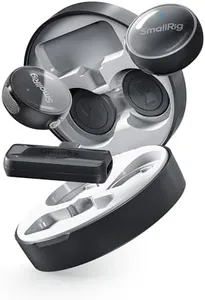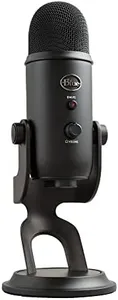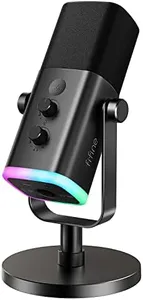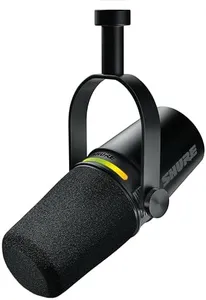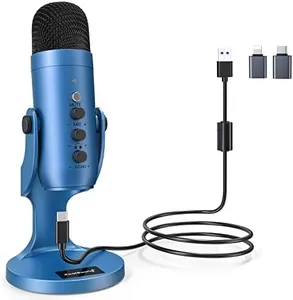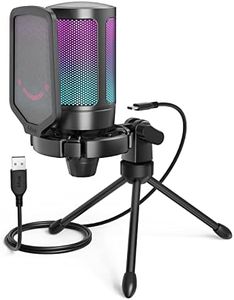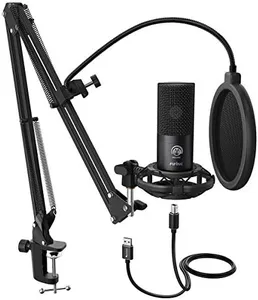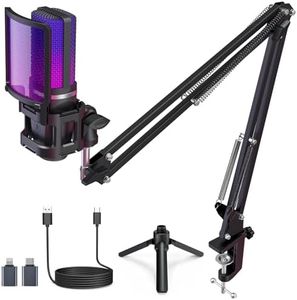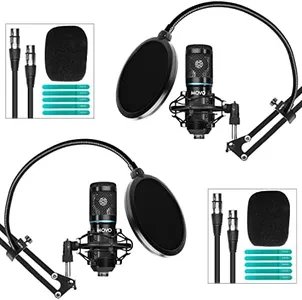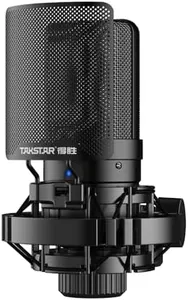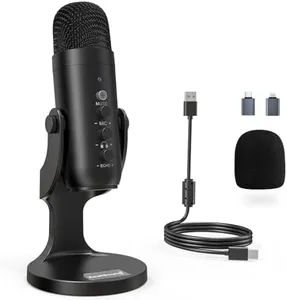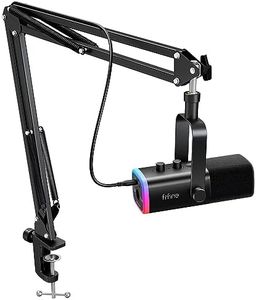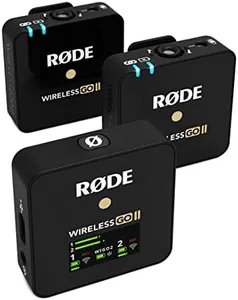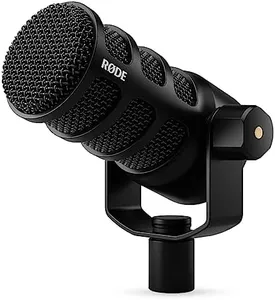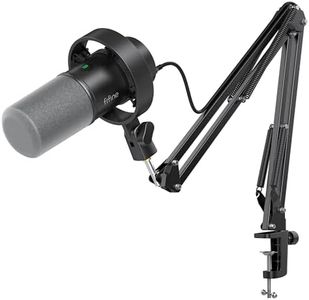10 Best Usb Microphones 2025 in the United States
Our technology thoroughly searches through the online shopping world, reviewing hundreds of sites. We then process and analyze this information, updating in real-time to bring you the latest top-rated products. This way, you always get the best and most current options available.

Our Top Picks
Winner
Logitech for Creators Blue Yeti USB Microphone for Gaming, Streaming, Podcasting, Twitch, YouTube, Discord, Recording for PC and Mac, 4 Polar Patterns, Studio Quality Sound, Plug & Play-Blackout
Most important from
34415 reviews
The Logitech for Creators Blue Yeti USB Microphone is an excellent choice for anyone engaged in gaming, streaming, podcasting, or content creation. Its standout feature is the custom three-capsule array that delivers clear, professional-quality sound, making it ideal for YouTube videos, live streaming on Twitch, and Zoom meetings. The multiple pickup patterns—cardioid, omni, bidirectional, and stereo—offer great flexibility, allowing users to record vocals, instruments, or podcasts without needing extra microphones.
This microphone is designed with ease of use in mind. The plug-and-play setup means you can start recording in just seconds on both Mac and PC, making it user-friendly for beginners. Onboard audio controls such as headphone volume, mic gain, and pattern selection provide a high level of control over your audio output. The no-latency monitoring feature is another highlight, allowing you to hear your own voice in real-time while recording.
While the Blue Yeti performs exceptionally well in many scenarios, its size and weight (3.51 pounds) might be a consideration for those needing a more portable solution. Additionally, while it excels in studio environments, it may pick up background noise in less controlled settings due to its sensitivity. Some users might also find the software, Blue VOICE, beneficial for enhancing audio but might require some learning to utilize its full potential.
Most important from
34415 reviews
FIFINE USB/XLR Dynamic Microphone for Podcast Recording, PC Computer Gaming Streaming Mic with RGB Light, Mute Button, Headphones Jack, Desktop Stand, Vocal Mic for Singing YouTube-AmpliGame AM8
Most important from
4960 reviews
The FIFINE USB/XLR Dynamic Microphone, known as the AM8, is a great choice for beginners and experienced users alike, especially for podcasting, gaming, and streaming. One of its standout features is its frequency response range of 50Hz to 16KHz, which allows it to capture clear and balanced audio, making your voice sound natural and engaging. The cardioid polar pattern is beneficial as it focuses on sound coming from the front while reducing background noise, ensuring your audience hears you clearly.
The dual connectivity options (USB and XLR) offer flexibility for different setups. The USB connection is user-friendly, making it easy to plug in and start recording, while the XLR option allows for more advanced configurations with sound cards and mixers. The built-in mute button and LED indicator provide practical control during live sessions, ensuring you can maintain privacy without fumbling around.
Another appealing aspect is the RGB lighting, which not only adds a fun aesthetic but can also be adjusted to match your gaming setup. The microphone’s design is sturdy, and it comes with a desktop stand, making it easy to position for optimal sound capture. Additionally, the built-in headphone jack and volume control ensure you can hear and adjust your audio in real-time, which is great for monitoring during recordings or streams.
However, there are some limitations to consider. The microphone is on the heavier side, which may not be ideal for travel. Users should also note that while it does come with a USB cable, the XLR cable and mic boom arm are not included, meaning extra purchases may be necessary for full functionality. Lastly, the noise level at 80 dB could be a consideration in very quiet environments, as it could pick up subtle background sounds.
The FIFINE AM8 is well-suited for those looking for an affordable yet versatile USB/XLR microphone that performs well for a variety of uses including gaming, streaming, and podcasting, offering a good balance of features and quality.
Most important from
4960 reviews
Shure MV7+ Podcast Dynamic Microphone. OBS Certified, Enhanced Audio, LED Touch Panel, USB-C & XLR Outputs, Auto Level Mode, Digital Pop Filter, Reverb Effects, Podcasting, Streaming, Recording -Black
Most important from
2933 reviews
The Shure MV7+ Podcast Dynamic Microphone is designed for podcasters, streamers, and musicians who need high-quality audio on various platforms. One of its standout features is its top-tier audio quality, especially with its Voice Isolation Technology that reduces background noise. This can be particularly beneficial for those in less-than-ideal recording environments. The microphone operates with both USB-C and XLR outputs, offering flexibility depending on your recording setup, which is a definite plus for versatility.
The LED touch panel adds a fun visual element, allowing you to change colors and use it as an audio level meter. This feature can be appealing for users who like customization. The quick mute function is also handy, letting you silence the mic instantly when needed. The onboard reverb settings are a nice touch for musicians wanting to enhance recordings.
On the downside, while the MV7+ has impressive technology, it may feel overwhelming for beginners. The integration with the MOTIV MIX app for personalized settings might require some learning, which could be a barrier for those less familiar with audio equipment. Additionally, although the physical pop filter is helpful, some users may prefer a more traditional physical pop filter setup in certain recording situations. In terms of build quality, the metal construction feels sturdy, adding to its professional appeal. However, it weighs nearly 2 pounds, which might be cumbersome for mobile setups or for those who prefer lighter equipment.
Most important from
2933 reviews
Buying Guide for the Best Usb Microphones
Choosing the right USB microphone can significantly enhance your audio recording experience, whether you're podcasting, streaming, or recording music. The key is to understand the various specifications and how they align with your specific needs. By focusing on the right specs, you can ensure that you get a microphone that delivers the best sound quality for your particular use case.FAQ
Most Popular Categories Right Now
